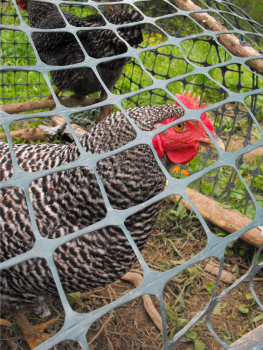
Chicken tractors as a permaculture tool

Our most obvious
permaculture technique is our chicken tractors. We have three of
them, and I wouldn't be surprised if we have twice that many in a few
years. For the uninitiated, a chicken tractor is a moveable
chicken coop/run with everything your chickens need in a small
space. Each morning, I move the tractors to a new patch of lawn,
where they scratch for bugs, engulf greenery, and fertilize the
ground. We get free lawnmowing and fertilizing along with better
eggs
while the chickens get healthy additions to their diet --- it's a
win-win.
 Animals are an important part of any natural
ecosystem, but most modern
farming tries to cut them out of the picture.
Chicken tractors
put animals back in, but in a controlled manner. Left to their
own devices, free range chickens would make short work of a vegetable
garden, eating up your tomatoes and strawberries, scratching your mulch
aside, and generally making a nuisance of themselves. (Yes, I
speak from personal experience.) On the other hand, pen chickens
up in a permanent coop/run and they will eat all of the greenery in a
matter of days, leaving bare earth which doesn't provide any of their
food.
Animals are an important part of any natural
ecosystem, but most modern
farming tries to cut them out of the picture.
Chicken tractors
put animals back in, but in a controlled manner. Left to their
own devices, free range chickens would make short work of a vegetable
garden, eating up your tomatoes and strawberries, scratching your mulch
aside, and generally making a nuisance of themselves. (Yes, I
speak from personal experience.) On the other hand, pen chickens
up in a permanent coop/run and they will eat all of the greenery in a
matter of days, leaving bare earth which doesn't provide any of their
food.
Some folks drag
the tractors directly over their garden to fertilize, but I've found
this is difficult with raised beds, and also gives the chickens less
food. So we added the mulching lawnmower to our chicken tractor
system, allowing us to cut grass fertilized by our chickens, then use
the greenery as mulch or compost in the garden. Thanks, hens!
| This post is part of our Permaculture lunchtime series.
Read all of the entries: |
We invented our homemade chicken
waterer specifically for tractors. Check it out to prevent
spilling of water on uneven terrain.
Want more in-depth information? Browse through our books.
Or explore more posts by date or by subject.
About us: Anna Hess and Mark Hamilton spent over a decade living self-sufficiently in the mountains of Virginia before moving north to start over from scratch in the foothills of Ohio. They've experimented with permaculture, no-till gardening, trailersteading, home-based microbusinesses and much more, writing about their adventures in both blogs and books.
Want to be notified when new comments are posted on this page? Click on the RSS button after you add a comment to subscribe to the comment feed, or simply check the box beside "email replies to me" while writing your comment.

I read somewhere (forget which blog) about someone who made their rows wide enough apart to fit a chicken tractor in between each of them. He would move it up one row and down another in an S pattern until he reached the end and then start over.
This kept the insect population down in the garden and fertilized the row path. Each year, he moves the hilled-up rows over a notch to where the paths were, and the area where the plants were then become the walking paths between rows. In this way the chickens are fertilizing a year ahead of time, which keeps their high-nitro-poo from burning tiny seedlings.
I might give it a shot one of these days, but for now I'm using raised beds boxed in with used lumber so it's not suitable for me.
I've read about that method too, but find it flawed. To me, the biggest plus of raised beds is that they're permanent so the soil never gets compacted by being walked on. Rotating their position every year with the path would negate this. (I hope I don't sound too stuffy --- I'm passionate about my raised beds.
On the other hand, Mark has considered building a skinny tractor just to mow the aisle. But it'd have to be pretty skinny, and corners would be difficult. For now, we just mow the aisle with the lawn mower since we have about an acre of grass for the chickens to nibble between the fruit trees and berry bushes.